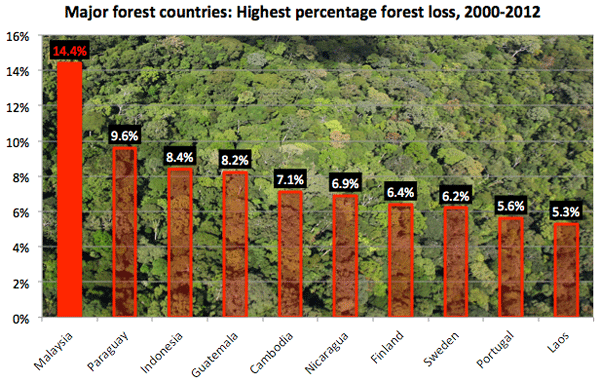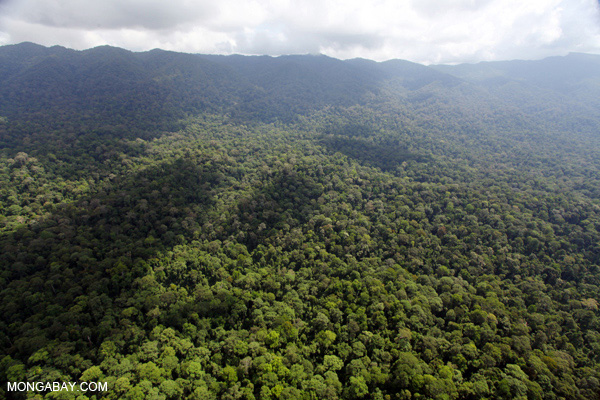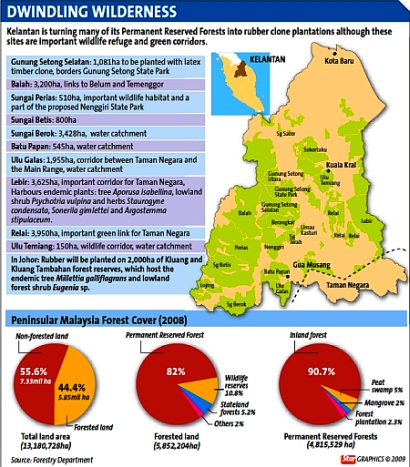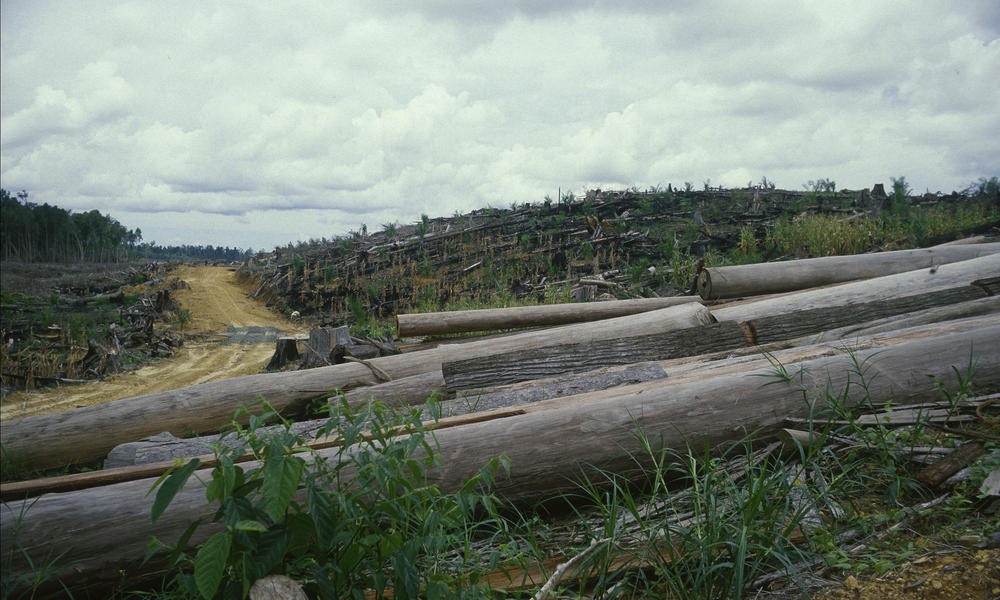There Is An Unspoken Loophole Sacrificing Our Protected Forests For Rubber Plantations
An area the size of Cyberjaya is being logged in the Lesong Permanent Forest Reserve to make way for single-species timber plantations. According to the Pahang government, the move is legal. But out research shows that a little known loophole in our forest policy is being exploited.
By now you should know that Malaysia has one of the world's highest deforestation rate
Malaysia is one of three countries in the world which had the highest national rates of deforestation, according to a new Google Earth mapping.
malaysiakini.comIn September, 3,000ha of the Lesong Permanent Forest Reserve was logged to make way for commercial timber plantations
Covering 80% of Malaysia's remaining forest cover are Permanent Forest Reserves (PFR) which are forest areas set aside for selective and sustainable logging
Much of the remaining forests in Peninsular Malaysia are retained within Permanent Reserved Forests (PRFs).
Permanent Reserved Forests form the bulk of the forest cover of Peninsular Malaysia, at 4,815,529ha or 36.5% of the land area. As the name indicates, these are forests to be kept in perpetuity. Yes, they are largely “timber production forest” meant for logging but under sustainable forestry management, they are supposed to be “selectively logged” – this means only big trees of stipulated sizes are cut while smaller trees are left behind to mature, to be logged 30 years down the road.
thestar.com.myHowever, a little-known loophole legalises the conversion of PFRs into monoculture rubber plantations
This loophole is allowing large expanses of natural forest on the peninsula (including those that are already being selectively logged) to be legally replaced by monocultures, such as latex-timber clones, commonly referred to as “rub- berwood”.
This alarming new trend appears to be widespread in Kelantan but forest reserves in Selangor and Johor have not been spared. The Star recently reported on the decimation of the Sungai Jelok forest reserve in Selangor and the Sungai Mas forest in Johor for rubber estates, while the Johor State Assembly has heard that 37,881ha of Terosot forest reserve will suffer the same fate.
kenviro.comRubberwood plantations are now expanding dramatically. From 2006 to 2007, the total area of Malaysian PRFs designated for rubberwood leapt from 1626 to 17443 ha – a nearly 11-fold increase.
The key problem is that the Forestry Act has a broad and ambiguous definition of "forest", it does not specifically say PFRs has to consist entirely of natural forest
A key problem, however, is that the Forestry Act does not stipulate the need for PRFs to consist entirely of natural forest, an ambiguty worsened by an overly broad definition of “forest” adopted by the UN Food and Agriculture Organization.
“PRF are classed as Environmentally Sensitive Areas Rank Two in the National Physical Plan whereby no development or agriculture is allowed. So all latex timber clone projects in forest reserves should not have been approved,” he says. “But what we are seeing today is wholesale clearing of PRF and massive conversion to plantations,” says Worldwide Fund for Nature Malaysia (WWF) chief technical officer Surin Suksuwan.
thestar.com.myThis means that natural forests can be legally cleared and replanted with rubber trees as long as they provide "sustained yield"
“Under the Act, most PRF are classified as ‘timber production forest’ under ‘sustained yield’. This can be interpreted to mean that a forest that is clear-felled and then replanted with rubber trees, will provide ‘sustained yield’, thereby justifying the conversion into plantations,” forestry researcher Lim Teck Wyn.
thestar.com.myRubber plantations are highly valued for both its latex and timber that contributes to 80% of the wood supplied to the local furniture industry
Around 80% of the wood supplied to the local furniture industry in Peninsular Malaysia now comprises rubberwood, and investor interest in these clones is expected to rise in response to government tax incentives.
In 2013, the rubber industry contributed to RM33.73 billion in national exports
Image via Malaysian Rubber BoardBut it's not just rubber plantations, PFRs are also being converted into oil palm plantations, African mahogany, teak, among others
The threat is not only from rubber clone plantations. Despite governmental assurances that oil palms will only be cultivated on idle or degraded land, EIA reports show that estates will come up in these forest reserves in Kelantan: Batu Papan (2,000ha), Gunung Setong Selatan and Balah (4,307ha), Sungai Betis (2,626ha), Sungai Terah and Limau Kasturi (3,513ha), as well as Sokor Taku and Sungai Sator (808ha). In Pahang, 2,142ha of Cereh forest reserve near Kuantan will be planted with oil palm.
thestar.com.myPermanent forest reserves are also being converted for other types of plantations, including African mahogany, teak, Acacia, sentang, kelempayang, batai, and binuang, although latex-timber clones (LTC) is "favored."
mongabay.comThis development is driven by the government's target of 375,000ha of tree farms by 2020
The development is driven by the government's effort to expand timber plantations across the country and has been facilitated by a system which classifies single-species monocultures as forests.
mongabay.comThe Malaysian government has established a target of 375 000 ha of timber plantations for the year 2020.
Single-species tree farms will have devastating effects on the forest's ecology, biodiversity, and more
Environmental consultant Dr Sanath Kumaran points out that monoculture or single-species plantations come with a host of problems: clear-felling to harvest the logs will lead to soil erosion, susceptibility to fires, and low biodiversity.
thestar.com.myWhen natural forests give way to single-species tree farms, the forest’s ecology will begin to unravel. “Clear-felling natural forests and planting rubber trees inside forest reserves will impact many species that rely on these forests, many of which have endemic species,” says forestry researcher Lim Teck Wyn.
thestar.com.myPFRs are crucial for the survival of tigers as they are within tiger protection areas. The national animal is now critically endangered with only 340 Malayan tigers left in the peninsular.
“The loss of these forest reserves will mean failure of the Central Forest Spine plan,” says one wildlife official. Loss of these forests will also damper tiger conservation efforts for these PRF are all within the three tiger refuges identified in the National Tiger Action Plan as crucial for the survival of the big cat. “All the forest reserves are important tiger habitats and likely to be important for other wildlife as well,” says WWF’s Suksuwan.
thestar.com.myAreas currently slated for conversion in Peninsular Malaysia include those identified as important habitats and key ecological corridors for species such as the Malayan tiger (Panthera tigris jacksoni). Apart from diminishing forest biodiversity, the expansion of plantation mono- cultures may lead to losses of impor- tant ecosystem services and in- creased human–wildlife conflict.
"Our PFRs are being pecked away like a piece of bread thrown to a flock of chickens." The future of Malaysia's remaining natural forest cover is bleak if this continues unabated.
A large proportion of Malaysia’s remaining natural forest cover could be transformed into rubberwood if present trends continue unabated.
“Our PRF are being pecked away like a piece of bread thrown to a flock of chickens,” says one forestry consultant. “Forests are logged until degraded and not allowed to regenerate, thus providing the excuse to convert them into rubber plantations. This pattern has been going on. It is a convenient way to legitimise the act of clear-cutting natural forests, and turning PRF into forest plantations.”
thestar.com.mySingle-species tree farms are not natural forests. Ironically, these forest plantations are still labelled as PFRs. This is dangerous as Forest Department figures will not record a decline in forest cover.
The irony is that these forest plantations are still categorised as PRF, although being planted with a single tree species, they are nothing like natural forests. This labelling has severe repercussion: Forestry Department figures will not show a decline in forest cover despite massive tracts of natural forest being turned into neatly planted rows of rubber saplings.
thestar.com.myAlso, the converted area is not degazetted and replaced with a similar-sized tract of forest, as legally required when alienating PRF for agriculture or development. What this means in the long term is further shrinkages of our natural forest cover but on paper, all looks well as PRF figures remain unchanged.
thestar.com.myTo remedy this, forest researchers are advising the government to revise its current definition of "forest" and to carefully scrutinise the national data to distinguish natural forests from plantations
We recommend that national data on tropical forest cover in Asia be carefully scrutinized to distinguish between natural forests (including selectively logged forests) and those converted into plantations.
We also urge the FAO to revise its current definition of “forest” to exclude plantations of rubber and other monocultures. Otherwise, large reserves of natural forest could be replaced by greatly simplified monocultures like rubberwood.









